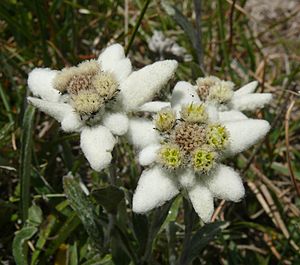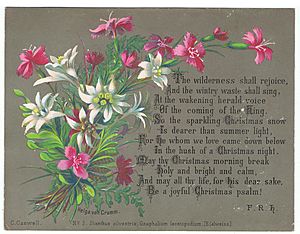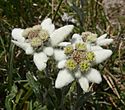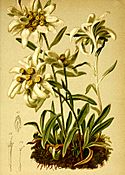Edelweiss facts for kids
Quick facts for kids Edelweiss |
|
|---|---|
 |
|
| Scientific classification | |
| Kingdom: | |
| (unranked): | |
| (unranked): | |
| (unranked): | |
| Order: | |
| Family: | |
| Tribe: |
Gnaphalieae
|
| Genus: |
Leontopodium
|
| Species: |
L. alpinum
|
| Binomial name | |
| Leontopodium alpinum Cass., 1822
|
|
The Edelweiss is a famous European mountain flower. Its scientific name, Leontopodium alpinum, comes from Greek words meaning "lion's paw," because of how its flowers look.
Contents
What is Edelweiss?
The leaves and flowers of the Edelweiss plant are covered with soft, white hairs, making them look very woolly. Each Edelweiss bloom has about five to six small yellow flower heads. These are surrounded by fuzzy white "petals," which are actually special leaves called bracts. These bracts form a cool star shape around the yellow center.
In the wild, Edelweiss plants can grow from about 3 to 20 centimeters tall. If they are grown in a garden, they can get a bit taller, up to 40 centimeters. You can usually see these beautiful flowers blooming between July and September.
-
This picture shows an Edelweiss early in the season, before its central flowers are fully grown. It was found in Slovakia's Tatra Mountains.
Protecting Edelweiss
Even though Edelweiss is well-known, it used to be collected too much. Because of this, its numbers started to drop. Luckily, the Edelweiss is now a protected plant. Laws help keep it safe, and it also grows in national parks where it can't be picked. Scientists also work to grow it in special gardens to help its population. The IUCN says it's a "least concern species," meaning it's not currently in danger of disappearing, thanks to these efforts.
Growing Edelweiss
People sometimes grow Edelweiss in their gardens. They like it because of its interesting flowers and its pretty silver-colored leaves. These plants don't live for a very long time, but you can easily grow new ones from seeds.
Why Edelweiss is a Symbol

For a long time, the Edelweiss has been a special symbol. In the 1800s, it became a sign of the wild, pure nature of the Alps mountains and the people who live there.
A writer named Berthold Auerbach wrote a novel called Edelweiss in 1861. In the story, it was very hard for a mountain climber to find an Edelweiss flower. People even started to believe that if you had an Edelweiss, it meant you were super brave! This idea became part of the popular stories about early alpinism.
An American writer, Ralph Waldo Emerson, once wrote about the Edelweiss. He said it grows on the highest, hardest-to-reach cliffs in the mountains. He mentioned that hunters would climb dangerous places to get the flower for Swiss maidens, who valued it greatly. He even said that sometimes hunters were found dead at the bottom of cliffs with the flower in their hand. He explained that the Swiss call it EDELWEISS, which means NOBLE PURITY.
Edelweiss in History
The Edelweiss has been used as a symbol in many ways throughout history:
- Before 1914:
- In the Swiss army, the highest-ranking officers wear badges shaped like Edelweiss flowers instead of stars.
- In 1907, the Edelweiss became the symbol for Austrian-Hungarian mountain troops. They wore it on their uniform collars.
- During World War I (1915), German mountain troops were given the Edelweiss symbol for being brave.
- Today, it is still the symbol for mountain troops in Austria, Poland, Romania, and Germany.
- During the World Wars:
- The song Stelutis alpinis (which means "Little edelweisses" in the Friulian language) was written during World War I. It's now like an unofficial anthem for the Friuli region in Italy.
- Another song, Es War Ein Edelweiss, was written for soldiers during World War II.
- The Edelweiss was a special badge for the Edelweiss Pirates. These were groups of young people in Germany during the time of the Nazis who bravely stood up against them. They wore the Edelweiss on their clothes.
- The Edelweiss flower was also a symbol for the mountain soldiers (called Gebirgsjäger) in the German army during World War II. They wore it as a metal pin or a patch. It is still the symbol of the mountain brigade in the German army today.
- A German air force unit during World War II, called Kampfgeschwader 51, was known as the Edelweiss Wing.
- A recording from 1934, sung by Harry Steier, mentioned the Edelweiss as a favorite flower of a leader at that time.
- After 1945:
- Since 2002, the Austrian two-cent coin has a picture of an Edelweiss.
- From 1959 to 2001, the Austrian one-schilling coin also showed a bunch of three Edelweiss flowers.
- The Edelweiss is a symbol for many groups, like the Bulgarian Tourist Union and the Bulgarian Mountain Control and Lifeguard Service.
- It's also the symbol of the Swiss national tourism organization.
- You can see the Edelweiss on the Romanian fifty-lei banknote.
- An Austrian beer brand is named Edelweiß.
- Many alpine clubs, like the Deutscher Alpenverein (German Alpine Club), use the Edelweiss in their logos.
- In the comic book Asterix in Switzerland (1970), the characters go on a quest to find Edelweiss in the Swiss mountains to help cure someone.
- Edelweiss Air, an international airline from Switzerland, is named after the flower and has it in its logo.
- "Bring me Edelweiss" is a well-known song by the music group Edelweiss.
- The Polish ice hockey team MMKS Podhale Nowy Targ uses an Edelweiss as its emblem.
- The Edelweiss Lodge and Resort is a military resort in Germany.
Symbolic Use Image Gallery
- Some symbolic uses of the Edelweiss from old times to today
-
This is the Iron Edelweiss from Enns, Austria. It was a monument from World War I to raise money.
-
A photo from the Nazi era showing the KG 51 symbol on a Ju 88 bomber plane.
-
A Kyrgyz postage stamp from 1994.
-
On a gold 100 Swiss francs coin from 1925.
-
A 500 tenge coin from Kazakhstan.
-
The coat of arms of Au, Austria.
-
The coat of arms of Brașov county, Romania.
-
On the hat and collar of Austria's Engelbert Dollfuss around 1933.
Images for kids
See also
 In Spanish: Flor de las nieves para niños
In Spanish: Flor de las nieves para niños




































